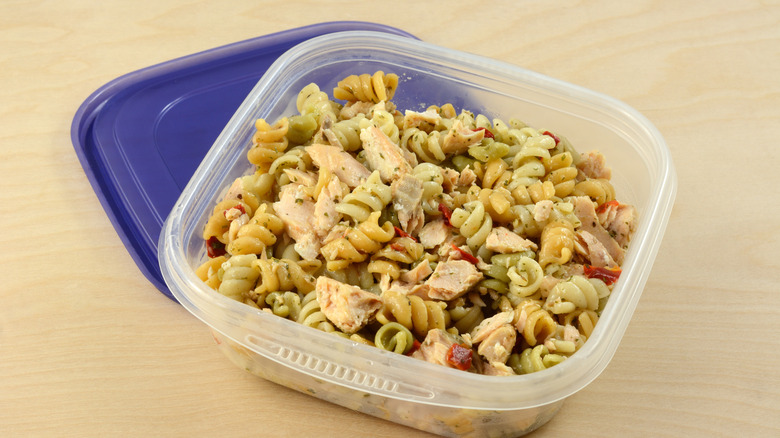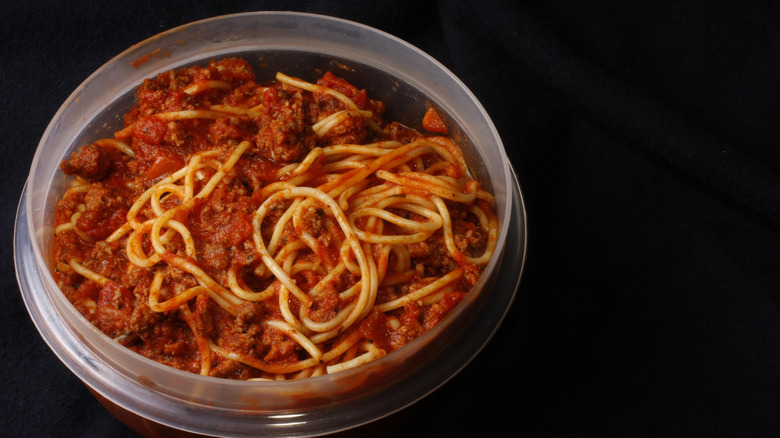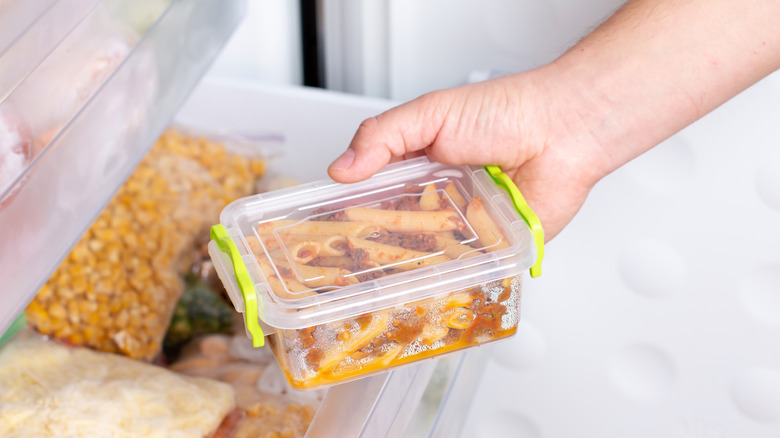How Long A Batch Of Cooked Pasta Will Last In The Fridge
It's the backbone of a whole cuisine, it's the perfect weeknight dinner, it's a crowd pleaser for even the littlest, pickiest eaters, and a staple no pantry is complete without a box of. It's pasta, of course, and it's no exaggeration to say it is one of the simple joys of life. Whether you're eating homemade hand-cut pasta in Italy (lucky you!) or boiling inexpensive grocery store elbows for a simple mac and cheese, pasta is delicious, non-fussy, and something even a novice home cook can master. And luckily, with a little bit of food safety know-how under your belt, it's also the perfect carb source to make once and eat for days.
As a rule of thumb, once you stick your leftover cooked pasta in the fridge, you should plan to use it up within three to four days, which is roughly the window of time you're afforded before signs of aging and decay set in. When kept in an airtight container in the fridge (which wards off but doesn't completely prevent the development of harmful bacteria and mold), you might get away with pasta staying good for close to a week, at best. Remember though, when it comes to food safety, it's always better to be safe than sorry.
Various types of pasta age differently
For such a simple food — most pasta is merely flour and water — it can be surprisingly confusing to know how to best cook and store it. For example, knowing how to properly reheat pasta is a game changer, and once you learn why you should always finish your pasta in a pan, you'll never look back. Similarly, knowing how to handle your leftovers matters — as no one wants to waste food. Not all pasta is created equal though; a quick glance at the pasta aisle in the grocery store will tell you that, and each ages slightly differently.
For example, fresh, store-bought wheat pastas tend to expire within only one to three days, whereas your alternative pastas — like gluten-free and lentil — usually keep for three to four days. With lasagna or other pastas with sauces, you may get away with one or two additional days. Looking to buy yourself more time to eat up those leftovers? Though you'll sacrifice a bit in terms of texture, you can always freeze your cooked pasta, then reheat weeks or months later.
To keep your penne or linguine from clumping up or drying out, always store it in a container with a lightly fitting lid, or cover a bowl of pasta with aluminum foil to keep air out. If possible, always store sauce and noodles separately to best preserve freshness and optimal texture.
In terms of nutrition, pasta actually gets better with age
There are plenty of foods you can get away with eating the next day but never exactly live up to their day one glory. And then there are the faves of leftover-lovers everywhere — those foods that blessedly, only get better with age. Think of savory dishes like soups and casseroles, or even things like steel-cut oats, where flavors mature, textures improve, and sometimes, such as in the case of old pasta, health benefits increase.
As freshly cooked pasta cools in the fridge, the naturally occurring starches undergo some shape-shifting, meaning the way our bodies utilize the starches in a steaming hot plate of baked ziti, for example, is different from how we can use the starches in a serving of leftovers from that same dish. If that sounds like pseudo-science, hear this out. As cooked pasta chills, more of its starches become what's known as "resistant starch," which are optimal for blood sugar level and gut health and provide extra fiber, as well as a host of other potential benefits that outpace freshly cooked noodles. Can your container of leftovers not only save you from grabbing takeout but also potentially boost your health? The science says yes.
You don't have to eat the leftovers cold to reap the health benefits, so feel free to reheat last night's spaghetti or eat it cold straight out of the container. No judgment either way.
How to tell if your pasta has gone bad
Ever tossed some leftover pasta in a container and stashed it in the fridge, only to find it hiding behind other leftovers days, maybe a week later? Join the club. If your leftovers got away from you and you're unclear if the pasta can still be eaten or if it needs to be dumped, there are a few telltale signs to keep a discerning eye (and nose) out for. Wasting food hurts, but safety is always #1, and you don't want to risk eating harmful bacteria that can cause stomach woes and worse– it's never worth it.
Luckily, it's pretty easy to tell if leftover pasta is safe or past the point of no return. Texture is a big clue, so look out for any noodles that have turned slimy or filmy. There are also clear visual signs like moldy spots or changes to the color. Notice a funky smell coming from that food container? It's time to toss. If you're within the safe window of time and your pasta looks, smells, and feels normal — chow down. But if you can't be sure, it's time to add those leftovers to the compost bin.



